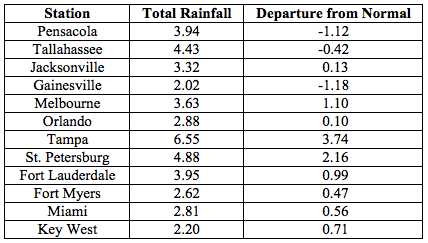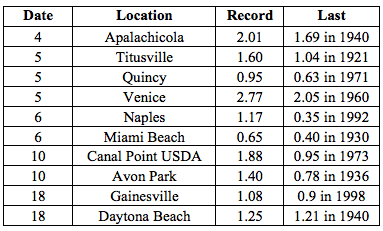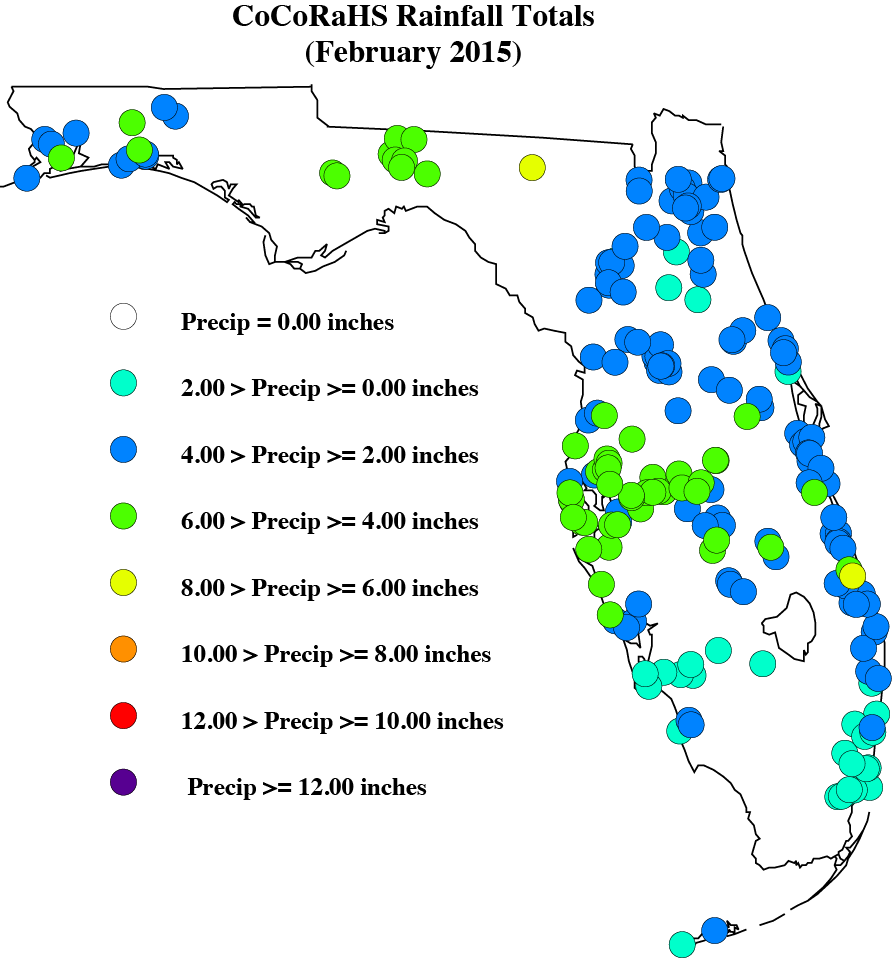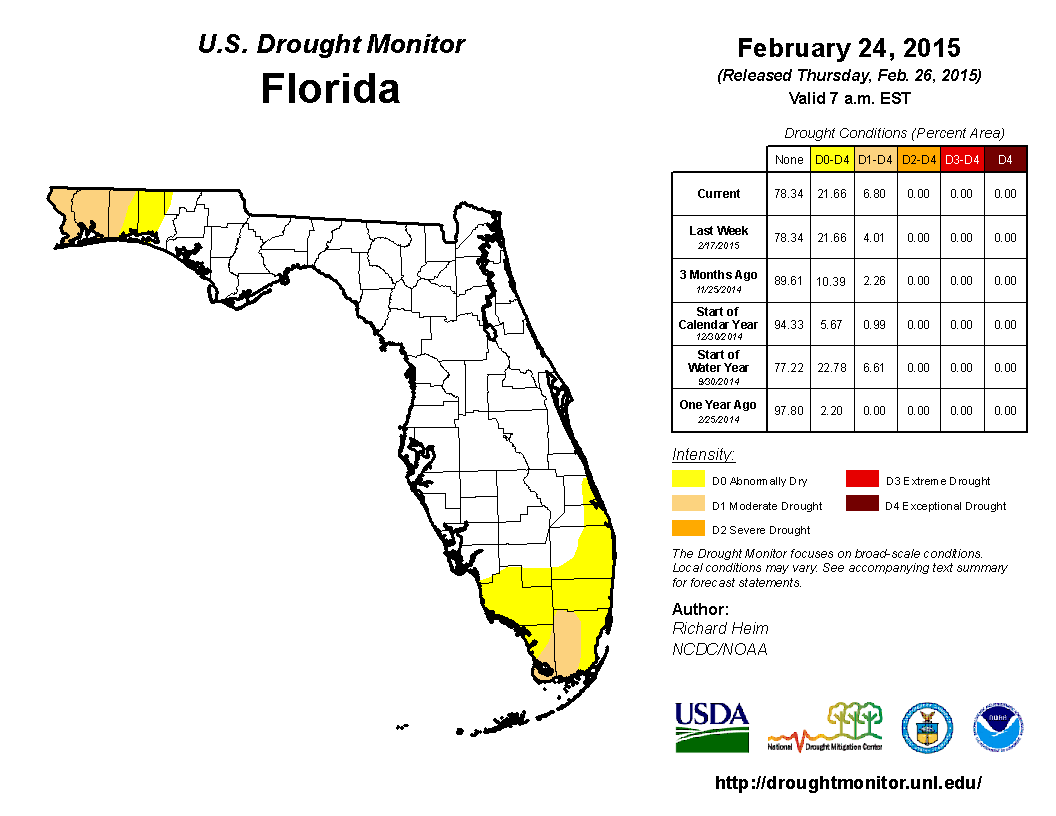 |
|
CoCoRaHS
F L O R I D A
A Community Collaborative
Rain, Hail & Snow Network
|
|
|
|
 |
 |
 |
 |
 |
 |
 |
 |
 |
 |
 |
 |
 |
February was an extremely busy month for me. From attending a workshop on the importance of fire in the ecosystem and helping set a prescribed burn, to judging science fairs, and taking my 'Weather Magic Show' on the road to local schools and community events... I packed as much as I could into each day. Even with the non-stop schedule, I kept up with reading your comments. I'm happy that many of you are looking forward to the return of spring- believe me, so am I!
So here are just a few of the comments that were my favorites during the month of February.
FL-SS-8 on 2/5/2015: "Raining cats dogs chickens and frogs and still coming down. Heavy ditches full of water rain- started around 1 or 2 am with no let up"
FL-SW-1 on 2/10/2015: "The high was 65.77 degrees F and the low was 49.80 degrees F. The FAWN Station a couple of miles East of this location had 0.03 inches of rain. Patchy fog overnight. Cloudy morning. Robins back already, sticky weed here and plants flowering that usually don't do so for another month. However, there is a usual cold snap coming soon, and we will see if the long-range forecast of the last half of February being below normal temps comes true. Hope not!"
FL-HL-2 on 2/20/2015: "29F @ 7am and I expect to find damage to several tropical plants in the yard as well as damage to the sensitive mango blossoms. Pineapple beds also will need to be assessed for freeze kill. This is the first freeze in the past four winters at this station."
FL-MD-61 on 2/20/2015: " I got down to 38 degrees this morning."
FL-JF-9 on 2/26/2015: "Strong storm last night started about 815p. Heavy rain, wind, lightning for about 1 hr starting 830p. Power off from 830p-1230a. Many LARGE branches down this morning. Reminded me of hurricane squalls."
|
Daylight Saving Time
Just a friendly reminder to everyone that Daylight Saving Time begins at 2:00 AM on Sunday, March 8th. Make sure that, before you go to bed the night of the 7th, you turn your clock ahead by one hour to reflect the change. Just to let you know, your CoCoRaHS observations will continue to stay on local time. If your normal observation time was at 7 AM EST, it becomes 7 AM EDT after the time change. This should help avoid some confusion, but if you have questions, please feel free to drop me an email.
|
March Madness Recruiting Drive
If you made your daily reports during the first few days of March, then you saw the notice about our annual March Madness contest. For those of you new to the network, we are running a little friendly competition at CoCoRaHS called 'March Madness' (not to be confused with the NCAA Basketball Tournament). We are trying to see which state can recruit the most observers in the month of March. North Carolina (155) edged out the Sunshine State (138) last year in the traditional count category and Wyoming won the per capita count, which meant both states took home the 'CoCoRaHS Cups'. There was a picture that was sent out in the April 2014 Newsletter of me conceding to one of the North Carolina coordinators. I would like to put on a strong showing this year, and even if we don't win the competition this year, I'd like to see if we are able to recruit at least 50 new observers in Florida this month. So if you know someone (relative or friend) who might be interested in joining the program, now would be a perfect time to get him or her to sign up.
|
Observer Photos
This month, Ben provided a picture of this 'Florida Snowman' outside of his house on the morning of February 20th, when it was only 28˚F.
Florida is known as one of the top birding states in the U.S., and Don from Tampa proves it through these beautiful pictures he sent me earlier this month.
   
If you've got any pictures you took on your travels, rainfall, floods, drought impacts, beautiful sunrises and sunsets, or anything else you'd like to share, please send them to me.
|
Quick Facts About February Observations
Registered Observers:
| 1,575 | Active Observers:
| 537 | Reports Submitted:
| 12,199 | Date of Most Reports:
| 484 on the 18th | Highest Rain Report:
| 4.10 on the 5th (FL-SS-40) | | Number of Observer Comments: | 1,399 |
|
February Rains
Rainfall totals were varied across the state in February. Most of the western Panhandle and the northern Peninsula saw below normal rainfall during February, while portions of the Big Bend, Central Florida and the East Coast had rainfall totals above normal (Figure 1). Departures from normal roughly ranged from -1.18" to 3.74" (Table 1), though localized parts of state saw rainfall totals that were as much as 4.00" below normal to over 5.00" above normal (Figure 1). February 2015 was the 7th wettest on record in Tampa and Orlando, the 9th wettest for Plant City and the 10th wettest in Hialeah. A significant rain event took place in the Broward and Dade counties on the 28th, where some locations along the coast picked up over 5" of rain. There were multiple 24-hour precipitation records broken for the month (Table 2).
Table 1. February precipitation totals and departures from normal (inches) for selected cities.

Table 2. Select daily rainfall records (inches) broken during February (Compiled from NOAA, NWS)

Figure 1. A graphical depiction of the monthly rainfall departure from normal (inches) for January is given in the figure below (courtesy of NOAA, NWS).
|
February CoCoRaHS Totals
Here are the CoCoRaHS rainfall totals for February from some select CoCoRaHS stations across the state.

|
Current State of the Drought
February started off with nearly 14% of the state reporting abnormally dry (D0) conditions, with the main concentration of the dryness located in the western Panhandle and southern Florida. Widespread rainfall impacted the state on the 5th and 6th of February, but the dry start to the month exacerbated conditions in the southern part of the state, and D0 was added to all of Broward and Collier counties and extended along coastal Indian River and St. Lucie counties. Another storm system brought rain to the Panhandle on the 17th and 18th, however near the end of the month, moderate drought (D1) conditions were introduced in portions of Miami-Dade and Monroe counties, especially in the Everglades National Park. The lack of rainfall throughout the month caused the expansion of existing D1 in Escambia County into all of Santa Rosa and western portions Okaloosa counties in the Panhandle. At the end of the month, the water level in Lake Okeechobee had dropped to under 15 ft., mainly due to regulatory releases. Heavy rains in portions of Alabama and Georgia caused rivers in northern Florida to rise, with some minor flooding along the Choctawhatchee, Apalachicola, Ochlockonee, and Withlacoochee.

|
Odds and Ends
Make sure to check out the monthly Wx Talk Webinars offered by CoCoRaHS. Each month features a different weather related topic and gives a chance for our observers to interact with the speaker. If you are unable to attend or have missed some of the previous month's talks, you can find them archived on the CoCoRaHS YouTube site: http://www.youtube.com/cocorahs/
Make sure to like Florida CoCoRaHS on Facebook! Observers can now post comments and pictures to the wall.
|
|
|
|
 |
 |
 |
 |
 |
 |
 |
 |
 |
 |
 |
 |
 |
|
|
 |
 |
|
 |
|